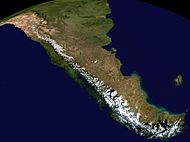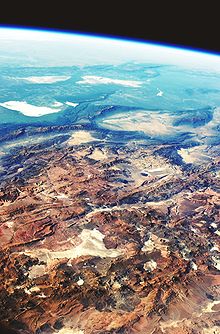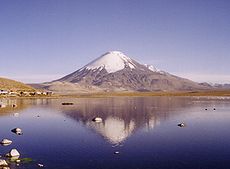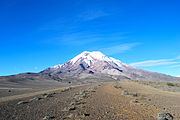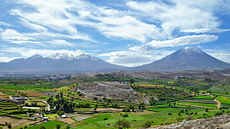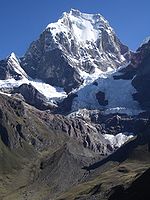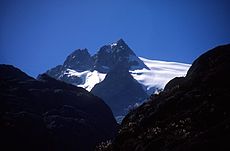
Andes
Background Information
SOS Children volunteers helped choose articles and made other curriculum material Do you want to know about sponsoring? See www.sponsorachild.org.uk
| Andes | |
|---|---|
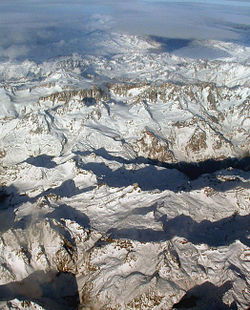 Aerial photo of a portion of the Andes between Argentina and Chile |
|
| Highest point | |
| Peak | Aconcagua ( Las Heras Department, Mendoza, Argentina) |
| Elevation | 6,962 m (22,841 ft) |
| Coordinates | 32°39′10″S 70°0′40″W Coordinates: 32°39′10″S 70°0′40″W |
| Dimensions | |
| Length | 7,000 km (4,300 mi) |
| Width | 500 km (310 mi) |
| Naming | |
| Native name | Quechua: Anti(s/kuna) |
| Geography | |
| Countries |
List
|
| Settlements | |
The Andes is the longest continental mountain range in the world. It is a continual range of highlands along the western coast of South America. This range is about 7,000 km (4,300 mi) long, about 200 km (120 mi) to 700 km (430 mi) wide (widest between 18° south and 20° south latitude), and of an average height of about 4,000 m (13,000 ft). The Andes extend from north to south through seven South American countries: Argentina, Bolivia, Chile, Colombia, Ecuador, Peru, and Venezuela.
Along its length, the Andes is split into several ranges, which are separated by intermediate depressions. The Andes is the location of several high plateaux – some of which host major cities such as Quito, Bogotá, Arequipa, Medellín, Sucre, and La Paz. The Altiplano plateau is the world's second-highest plateau following the Tibetan plateau.
The Andes range is the world's highest mountain range outside of Asia. The highest peak, Mount Aconcagua, rises to an elevation of about 6,962 m (22,841 ft) above sea level. The peak of Chimborazo in the Ecuadorean Andes is farther from Earth's centre than any other location on Earth's surface, due to the equatorial bulge resulting from Earth's rotation. The world's highest volcanoes are in the Andes, including Ojos del Salado on the Chile-Argentina border which rises to 6,893 m (22,615 ft). Over fifty other Andean volcanoes also rise above 6,000 m (19,685 ft).

Name
The etymology of the word Andes has been debated. The major consensus is that it derives from the Quechua word anti, which means "high crest". Others believe that Andes comes from Anti Suyu, one of the four regions of the Inca empire. It is more likely, however, that the word Antisuyo derives from the use of Anti to designate mountain chains. Derivation from the Spanish andén (in the sense of cultivation terrace) has also been proposed, yet considered very unlikely.
Geography
The Andes can be divided into three sections:
- The Southern Andes (south of Llullaillaco) in Argentina and Chile;
- The Central Andes in Ecuador, Peru and Bolivia
- The Northern Andes (north of the Nudo de Pasto) in Venezuela and Colombia that consists of three parallel ranges, the western, central, and eastern ranges. (The cordillera occidental, central, and oriental).
In the northern part of the Andes, the isolated Sierra Nevada de Santa Marta range is often considered to be part of the Andes. This eastern range of Colombia is the only one that extends to Venezuela. The term cordillera comes from the Spanish word "cuerda", meaning "rope". The Andes range is about 200 km (124 mi) wide throughout its length, except in the Bolivian flexure where it is about 640 kilometres (398 mi) wide. The islands of the Dutch Caribbean Aruba, Bonaire, and Curaçao, which lie in the Caribbean Sea off the coast of Venezuela, were thought to represent the submerged peaks of the extreme northern edge of the Andes range, but ongoing geological studies indicate that such a simplification does not do justice to the complex tectonic boundary between the South-American and Caribbean plates.
Geology
The Andes are a Mesozoic – Tertiary orogenic belt of mountains along the Pacific Ring of Fire, a zone of volcanic activity that encompasses the Pacific rim of the Americas as well as the Asia-Pacific region. The Andes are the result of plate tectonics processes, caused by the subduction of oceanic crust beneath the South American plate. The main cause of the rise of the Andes is the compression of western rim of the South American Plate due to the subduction of the Nazca Plate and the Antarctic Plate. To the east, the Andes range is bounded by several sedimentary basins such as Orinoco, Amazon Basin, Madre de Dios and Gran Chaco which separates the Andes from the ancient cratons in eastern South America. In the south the Andes shares a long boundary with the former Patagonia Terrane. To the west, the Andes end at the Pacific Ocean, although the Peru-Chile trench can be considered its ultimate western limit. From a geographical approach the Andes are considered to have their western boundaries marked by the appearance of coastal lowlands and a less rugged topography.
Orogeny
The western rim of the South American Plate has been the place of several pre-Andean orogenies since at least the period of the late Proterozoic and early Paleozoic when several terranes and microcontinents collided and amalgamated with the ancient cratons of eastern South America, by then the South American part of Gondwana.
The formation of the modern Andes began with the events of the Triassic when Pangea began to break up and several rifts developed. It continued through the Jurassic Period. It was during the Cretaceous Period that the Andes began to take its present form, by the uplifting, faulting and folding of sedimentary and metamorphic rocks of the ancient cratons to the east. The rise of the Andes has not been constant and different regions have had different degrees of tectonic stress, uplift, and erosion.
Tectonic forces above the subduction zone along the entire west coast of South America where the Nazca Plate and a part of the Antarctic Plate are sliding beneath the South American Plate continue to produce an ongoing orogenic event resulting in minor to major earthquakes and volcanic eruptions to this day. In the extreme south a major transform fault separates Tierra del Fuego from the small Scotia Plate. Across the 1,000 km (620 mi) wide Drake Passage lie the mountains of the Antarctic Peninsula south of the Scotia Plate which appear to be a continuation of the Andes chain.
Volcanism

The Andes range has many active volcanoes, which are distributed in four volcanic zones separated by areas of inactivity. The Andean volcanism is a result of subduction of the Nazca Plate and Antarctic Plate underneath the South American Plate. The belt is subdivided into four main volcanic zones that are separated from each other by volcanic gaps. The volcanoes of the belt are diverse in terms of activity style, products and morphology. While some differences can be explained by which volcanic zone a volcano belongs to, there are significant differences inside volcanic zones and even between neighbouring volcanoes. Despite being a type location for calc-alkalic and subduction volcanism, the Andean Volcanic Belt has a large range of volcano-tectonic settings, such as rift systems and extensional zones, transpersonal faults, subduction of mid-ocean ridges and seamount chains apart from a large range on crustal thicknesses and magma ascent paths, and different amount of crustal assimilations.
Ore deposits and evaporites
The Andes mountains host large ore and salt deposits and some of its eastern fold and thrust belt acts as traps for commercially exploitable amounts of hydrocarbons. In the forelands of the Atacama desert some of the largest porphyry copper mineralizations occurs making Chile and Peru the first and second largest exporters of copper in the world. Porphyry copper in the western slopes of the Andes has been generated by hydrothermal fluids (mostly water) during the cooling of plutons or volcanic systems. The porphyry mineralization further benefited from the dry climate that let them largely out of the disturbing actions of meteoric water. The dry climate in the central western Andes have also led to the creation of extensive saltpeter deposits which were extensively mined until the invention of synthetic nitrates. Yet another result of the dry climate are the salars of Atacama and Uyuni, the first one being the largest source of lithium today and the second the world’s largest reserve of the element. Early Mesozoic and Neogene plutonism in Bolivia's Cordillera Central created the Bolivian tin belt as well as the famous, now depleted, deposits of Cerro Rico de Potosí.
Climate and hydrology
The climate in the Andes varies greatly depending on latitude, altitude, and proximity to the sea. Temperature, atmospheric pressure and humidity decrease in higher elevations. The southern section is rainy and cool, the central Andes are dry. The northern Andes are typically rainy and warm, with an average temperature of 18 °C (64 °F) in Colombia. The climate is known to change drastically in rather short distances. Rainforests exist just miles away from the snow covered peak Cotopaxi. The mountains have a large effect on the temperatures of nearby areas. The snow line depends on the location. It is at between 4,500 and 4,800 m (14,800–15,800 ft) in the tropical Ecuadorian, Colombian, Venezuelan, and northern Peruvian Andes, rising to 4,800–5,200 m (15,800–17,060 ft) in the drier mountains of southern Peru south to northern Chile south to about 30°S, then descending to 4,500 m (14,760 ft) on Aconcagua at 32°S, 2,000 m (6,600 ft) at 40°S, 500 m (1,640 ft) at 50°S, and only 300 m (980 ft) in Tierra del Fuego at 55°S; from 50°S, several of the larger glaciers descend to sea level.
The Andes of Chile and Argentina can be divided in two climatic and glaciological zones; the Dry Andes and the Wet Andes. Since the Dry Andes extends from the latitudes of Atacama Desert to the area of Maule River, precipitation is more sporadic and there are strong temperature oscillations. The line of equilibrium may shift drastically over short periods of time, leaving a whole glacier in the ablation area or in the accumulation area.
In the high Andes of central Chile and Mendoza Province rock glaciers are larger and more common than glaciers; this is due to the high exposure to solar radiation.
Though precipitation increases with the height, there are semiarid conditions in the nearly 7000 m towering highest mountains of the Andes. This dry steppe climate is considered to be typically of the subtropic position at 32-34° S. Therefore in the valley bottoms do not grow woods but only dwarf scrub. The largest glaciers, as e.g. the Plomo glacier and the Horcones glaciers do not even reach 10 km in length and have an only insignificant ice thickness. At glacial times however, c. 20 000 years ago, the glaciers were over ten times longer. On the East-side of this section of the Mendozina Andes they flowed down to 2060 m and on the West-side to c. 1220 m asl. The massifs of Cerro Aconcagua (6962 m), Cerro Tupungato (6550 m) and Nevado Juncal (6110 m) are situated deca-kilometres away from each other and were connected by a joint ice stream network. Its dendritic glacier arms, i.e. components of valley glaciers, were up to 112.5 km long, over 1020, i.e. 1250 m thick and overspanned a vertical distance of 5150 altitude metres. The climatic glacier snowline (ELA) was lowered from currently 4600 m to 3200 m at glacial times.
Flora
The Andean region cuts across several natural and floristc regions due to its extension from Caribbean Venezuela to cold, windy and wet Cape Horn passing through the hyperarid Atacama Desert. Rainforests used to encircle much of the northern Andes but are now greatly diminished, especially in the Chocó and inter-Andean valleys of Colombia. As a direct opposite of the humid Andean slopes are the relatively dry Andean slopes in most of western Peru, Chile and Argentina. Along with several Interandean Valles, they are typically dominated by deciduous woodland, shrub and xeric vegetation, reaching the extreme in the slopes near the virtually lifeless Atacama Desert.
About 30,000 species of vascular plants live in the Andes with roughly half being endemic to the region, surpassing the diversity of any other hotspot. The small tree Cinchona pubescens, a source of quinine which is used to treat malaria, is found widely in the Andes as far south as Bolivia. Other important crops that originated from the Andes are tobacco and potatoes. The high-altitude Polylepis forests and woodlands are found in the Andean areas of Colombia, Ecuador, Peru, Bolivia and Chile. These trees, by locals referred to as Queñua, Yagual and other names, can be found at altitudes of 4,500 m (14,760 ft) above sea level. It remains unclear if the patchy distribution of these forests and woodlands is natural, or the result of clearing which began during the Incan period. Regardless, in modern times the clearance has accelerated, and the trees are now considered to be highly endangered, with some believing that as little as 10% of the original woodland remains.
Fauna

The Andes is rich in fauna: With almost 3,500 species, of which roughly 2/3 are endemic to the region, the Andes is the most important region in the world for amphibians. The diversity of animals in the Andes is high, with almost 600 species of mammals (13% endemic), more than 1,700 species of birds (about 1/3 endemic), more than 600 species of reptile (about 45% endemic), and almost 400 species of fish (about 1/3 endemic).
The Vicuña and Guanaco can be found living in the Altiplano, while the closely related domesticated Llama and Alpaca are widely kept by locals as pack animals and for their meat and wool. The nocturnal chinchillas, two threatened members of the rodent order, inhabit the Andes' alpine regions. The Andean Condor, the largest bird of its kind in the Western Hemisphere, occurs throughout much of the Andes but generally in very low densities. Other animals found in the relatively open habitats of the high Andes include the huemul, cougar, foxes in the genus Pseudalopex, and, for birds, certain species of tinamous (notably members of the genus Nothoprocta), Andean Goose, Giant Coot, flamingos (mainly associated with hypersaline lakes), Lesser Rhea, Andean Flicker, Diademed Sandpiper-plover, miners, sierra-finches and diuca-finches.
Lake Titicaca hosts several endemics, among them the highly endangered Titicaca Flightless Grebe and Titicaca Water Frog. A few species of hummingbirds, notably some hillstars, can be seen at altitudes above 4,000 m (13,100 ft), but far higher diversities can be found at lower altitudes, especially in the humid Andean forests (" cloud forests") growing on slopes in Colombia, Ecuador, Peru, Bolivia and far northwestern Argentina. These forest-types, which includes the Yungas and parts of the Chocó, are very rich in flora and fauna, although few large mammals exists, exceptions being the threatened Mountain Tapir, Spectacled Bear and Yellow-tailed Woolly Monkey.
Birds of humid Andean forests include mountain-toucans, quetzals and the Andean Cock-of-the-rock, while mixed species flocks dominated by tanagers and Furnariids commonly are seen - in contrast to several vocal but typically cryptic species of wrens, tapaculos and antpittas.
A number of species such as the Royal Cinclodes and White-browed Tit-spinetail are associated with Polylepis, and consequently also threatened.
Human activity
The Andes mountains form a north-south axis of cultural influences. A long series of cultural development culminated in the expansion of the Inca civilization and Inca Empire in the central Andes during the 15th century. The Incas formed this civilization through imperialistic militarism as well as careful and meticulous governmental management. The government sponsored the construction of aqueducts and roads in addition to preexisting installations. Some of these constructions are still in existence today.
Devastated by European diseases to which they had no immunity, and civil wars, in 1532 the Incas were defeated by an alliance composed of tens of thousands allies from nations they had subjugated (e.g. Huancas, Chachapoyas, Cañaris) and a small army of 180 Spaniards led by Francisco Pizarro. One of the few Inca sites the Spanish never found in their conquest was Machu Picchu, which lay hidden on a peak on the eastern edge of the Andes where they descend to the Amazon. The main surviving languages of the Andean peoples are those of the Quechua and Aymara language families. Woodbine Parish and Joseph Barclay Pentland surveyed a large part of the Bolivian Andes from 1826 to 1827.
In modern times, the largest Andean cities are Bogota, Colombia, with a population of about eight million, Santiago de Chile, and Medellin, Colombia.
Transportation
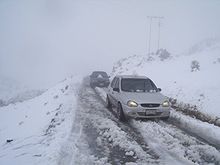
Several major cities exist either in the Andes or in the foothills, among which are Bogotá, Medellín and Cali, Colombia; Quito, Ecuador; Mérida, Venezuela; La Paz, Bolivia; Santiago, Chile, and Cusco, Peru. These and most other cities and large towns are now connected with asphalt-paved roads, while smaller towns are often connected by dirt roads, which may require a four-wheel-drive vehicle.
The rough terrain has historically put the costs of building highways and railroads that cross the Andes out of reach of most neighboring countries, even with modern civil engineering practices. For example, the main crossover of the Andes between Argentina and Chile is still accomplished through the Paso Internacional Los Libertadores. Only recently the ends of some highways that came rather close to one another from the east and the west have been connected. Much of the transportation of passengers is done via aircraft.
However, there is one railroad that connects Chile with Argentina via the Andes, and there are others that make the same connection via southern Bolivia. See railroad maps of that region.
There is one or more highway in Bolivia that cross the Andes. Some of these were built during a period of war between Bolivia and Paraguay, in order to transport Bolivian troops and their supplies to the war front in the lowlands of southeastern Bolivia and western Paraguay.
For decades, Chile claimed ownership of land on the eastern side of the Andes. However, these claims were given up in about 1870 during the War of the Pacific between Chile, the allied Bolivia and Peru, in a diplomatic deal to keep Argentina out of the war. The Chilean Army and Chilean Navy defeated the combined forces of Bolivia and Peru, and Chile took over Bolivia's only province on the Pacific Coast, some land from Peru, also - that was returned to Peru decades later. Bolivia has been a completely landlocked country ever since then. It mostly uses seaports in eastern Argentina and Uruguay for international trade because its diplomatic relations with Chile have been suspended since 1978.
Because of the tortuous terrain in places, villages and towns in the mountains — to which travel via motorized vehicles are of little use — are still located in the high Andes of Argentina, Bolivia, Peru, and Ecuador. Locally, the relatives of the camel, the llama, and the alpaca continue to carry out important uses as pack animals, but this use has generally diminished in modern times. Donkeys, mules, and horses are also useful.
Agriculture
The ancient peoples of the Andes such as the Incas have practiced irrigation techniques for over 6,000 years. Because of the mountain slopes, terracing has been a common practice. Terracing, however, was only extensively employed after Incan imperial expansions to fuel their expanding realm. The potato holds a very important role as an internally consumed staple crop. Maize was also an important crop for these people, and was used for the production of chicha, important to Andean native people. Currently, tobacco, cotton and coffee are the main export crops. Coca, despite eradication programmes in some countries, remains an important crop for legal local use in a mildly stimulating tisane, and, both controversially and illegally, for the production of cocaine.
Mining
The Andes rose to fame for its mineral wealth during the Spanish conquest of South America. Although Andean Amerindian peoples crafted ceremonial jewelry of gold and other metals the mineralizations of the Andes were first mined in large scale after the Spanish arrival. Potosí in present-day Bolivia and Cerro de Pasco in Peru were one of the principal mines of the Spanish Empire in the New World. Río de la Plata and Argentina derive their names from the silver of Potosí.
Currently, mining in the Andes of Chile and Peru places these countries as the 1st and 3rd major producers of copper in the world. Peru also contains the largest goldmine in the world; the Yanacocha goldmine. The Bolivian Andes produce principally tin although historically silver mining had a huge impact on the economy of 17th century Europe.
There is a long history of mining in the Andes, from the Spanish silver mines in Potosí in the 16th century to the vast current porphyry copper deposits of Chuquicamata and Escondida in Chile and Toquepala in Peru. Other metals including iron, gold and tin in addition to non-metallic resources are also important.
-
The mountain Huayna Picchu overlooks the ruins of Machu Picchu
Peaks
This list contains some of the major peaks in the Andes mountain range. The highest peak is Aconcagua of Argentina (see below).
Argentina
- Aconcagua, 6,962 m (22,841 ft)
- Cerro Bonete, 6,759 m (22,175 ft)
- Galán, 5,912 m (19,396 ft)
- Mercedario, 6,720 m (22,047 ft)
- Pissis, 6,795 m (22,293 ft)
Border between Argentina and Chile
- Cerro Bayo, 5,401 m (17,720 ft)
- Cerro Chaltén, 3,375 m (11,073 ft) or 3,405 m, Patagonia, also known as Cerro Fitz Roy
- Cerro Escorial, 5,447 m (17,871 ft)
- Cordón del Azufre, 5,463 m (17,923 ft)
- Falso Azufre, 5,890 m (19,324 ft)
- Incahuasi, 6,620 m (21,719 ft)
- Lastarria, 5,697 m (18,691 ft)
- Llullaillaco, 6,739 m (22,110 ft)
- Maipo, 5,264 m (17,270 ft)
- Marmolejo, 6,110 m (20,046 ft)
- Ojos del Salado, 6,893 m (22,615 ft)
- Olca, 5,407 m (17,740 ft)
- Sierra Nevada de Lagunas Bravas, 6,127 m (20,102 ft)
- Socompa, 6,051 m (19,852 ft)
- Nevado Tres Cruces, 6,749 m (south summit) (III Region)
- Tronador, 3,491 m (11,453 ft)
- Tupungato, 6,570 m (21,555 ft)
- Nacimiento, 6,492 m (21,299 ft)
-
Torres del Paine, Chile
Bolivia
- Janq'u Uma, 6,427 m (21,086 ft)
- Cabaraya, 5,860 m (19,226 ft)
- Chacaltaya, 5,421 m (17,785 ft)
- Wayna Potosí, 6,088 m (19,974 ft)
- Illampu, 6,368 m (20,892 ft)
- Illimani, 6,438 m (21,122 ft)
- Laram Q'awa, 5,520 m (18,110 ft)
- Macizo de Pacuni, 5,400 m (17,720 ft)
- Nevado Anallajsi, 5,750 m (18,865 ft)
- Nevado Sajama, 6,542 m (21,463 ft)
- Patilla Pata, 5,300 m (17,390 ft)
- Tata Sabaya, 5,430 m (17,815 ft)
Border between Bolivia and Chile
- Acotango, 6,052 m (19,856 ft)
- Michincha, 5,305 m (17,405 ft)
- Iru Phutunqu, 5,163 m (16,939 ft)
- Licancabur, 5,920 m (19,423 ft)
- Olca, 5,407 m (17,740 ft)
- Parina Quta, 6,348 m (20,827 ft)
- Paruma, 5,420 m (17,782 ft)
- Pomerape, 6,282 m (20,610 ft)
Chile
- Monte San Valentin, 4,058 m (13,314 ft)
- Cerro Paine Grande, c.2,750 m (9,022 ft)
- Cerro Macá, c.2,300 m (7,546 ft)
- Monte Darwin, c.2,500 m (8,202 ft)
- Volcan Hudson, c.1,900 m (6,234 ft)
- Cerro Castillo Dynevor, c.1,100 m (3,609 ft)
- Mount Tarn, c.825 m (2,707 ft)
- Polleras, 5,993 m (19,662 ft)
-
Santiago de Chile on the western slopes of a snowcapped Andes
Colombia
- Nevado del Huila, 5,365 m (17,602 ft)
- Nevado del Ruiz, 5,321 m (17,457 ft)
- Nevado del Tolima, 5,205 m (17,077 ft)
- Pico Pan de Azucar, 5,200 m (17,060 ft)
- Ritacuba Negra, 5,320 m (17,454 ft)
- Nevado del Cumbal, 4,764 m (15,630 ft)
- Cerro Negro de Mayasquer, 4,445 m (14,583 ft)
- Ritacuba Blanco, 5,410 m (17,749 ft)
- Nevado del Quindío, 5,215 m (17,110 ft)
- Purace, 4,655 m (15,272 ft)
- Santa Isabel, 4,955 m (16,257 ft)
- Doña Juana, 4,150 m (13,615 ft)
- Galeras, 4,276 m (14,029 ft)
- Azufral. 4,070 m (13,353 ft)
-
Ritacuba blanco the highest peak of Cordillera Oriental, Colombia.
Ecuador
- Antisana, 5,752 m (18,871 ft)
- Cayambe, 5,790 m (18,996 ft)
- Chimborazo, 6,268 m (20,564 ft)
- Corazón, 4,790 m (15,715 ft)
- Cotopaxi, 5,897 m (19,347 ft)
- El Altar, 5,320 m (17,454 ft)
- Illiniza, 5,248 m (17,218 ft)
- Pichincha, 4,784 m (15,696 ft)
- Quilotoa, 3,914 m (12,841 ft)
- Reventador, 3,562 m (11,686 ft)
- Sangay, 5,230 m (17,159 ft)
- Tungurahua, 5,023 m (16,480 ft)
- Titicacha, 5,035 m (16,519 ft)
Peru
- Alpamayo, 5,947 m (19,511 ft)
- Artesonraju, 6,025 m (19,767 ft)
- Carnicero, 5,960 m (19,554 ft)
- Chumpi, 6,106 m (20,033 ft)
- El Misti, 5,822 m (19,101 ft)
- El Toro, 5,830 m (19,127 ft)
- Huandoy, 6,395 m (20,981 ft)
- Huascarán, 6,768 m (22,205 ft)
- Jirishanca, 6,094 m (19,993 ft)
- Nevado de Huaytapallana, 5,557 m (18,232 ft)
- Pumasillu, 5,991 m (19,656 ft)
- Rasac, 6,040 m (19,816 ft)
- Rondoy, 5,870 m (19,259 ft)
- Sarapo, 6,127 m (20,102 ft)
- Seria Norte, 5,860 m (19,226 ft)
- Siula Grande, 6,344 m (20,814 ft)
- Yerupaja, 6,635 m (21,768 ft)
- Yerupaja Chico, 6,089 m (19,977 ft)
Venezuela
- Pico Bolívar, 4,981 m (16,342 ft)
- Pico Humboldt, 4,940 m (16,207 ft)
- Pico Bonpland, 4,880 m (16,010 ft)
- Pico La Concha, 4,870 m (15,978 ft)
- Pico Piedras Blancas, 4,740 m (15,551 ft)
- Pico El Águila, 4,018 m (13,182 ft)
- Pico El Toro 4,729 m (15,515 ft)
- Pico El León 4,740 m (15,551 ft)
- Pico Mucuñuque 4,609 m (15,121 ft)
